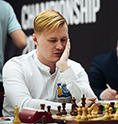16 December 2015
Playing as far as the First Error
The final battle of the Ugra classical chess marathon in the review of Dmitry Kryakvin.
As often happens in similar cases, the dramatic and eventful tournament would culminate to not the most spectacular finale. The opponents have been exhausted by the effort applied in the previous rounds: Ivan went through two Armageddons, whereas Dmitri was out of the tie-break with Fedoseev, which was worth the two "games of death." Besides, as was narrated by the finalists themselves, the past knockouts have never really worked out well for them. Two previous attempts of Bukavshin (the 2014 Russian Cup and the World Cup) finished up in the first round, while Kokarev had had a lot more experience of annoying misfires in the opening rounds. Off the top of my head I remember Dima being almost the last to finish his tiebreak against Alexey Korotylev in Serpukhov 2007, as well as the 2011 battle in Magnitogorsk against Igor Kovalenko with the subsequent Armageddon, mutual errors by both opponents and a broken clock... Therefore the Cup candidates used to act with a substantial margin of safety. The first game soon ended in a repetition of moves.
Kokarev – Bukavshin
Game 1
1.e4 e5 2.Nf3 Nc6 3.Bb5 Nf6
You haven’t anticipated the Berlin, have you?
4.d3 Bc5 5.Bxc6 dxc6
The unperturbed Dmitry Kokarev
6.b3

This rare anti-Berlin move was first employed by Luke McShane against Vladimir Kramnik in 2011. The game continued as follows: 6...Bg4 7.Nbd2 Nd7 8.Bb2 f6 9.Nf1 Nf8 10.h3 Bxf3 11.Qxf3 Ne6 12.Ne3 with an approximate equality, although the sharp fight that ensued saw the Russian taking the upper hand. Bukavshin came prepared for such developments and based his knowledge on the recent game of Kokarev against Schekachikhin from the 2015 Alekhine Memorial in Voronezh.
6…Nd7 7.Bb2 f6
The source game featured 7...Bd6 8.Nbd2 0-0 9.0-0 Re8 10.Nc4 c5 11.a4 f6 12.Nh4 Nf8 13.g3 Be6 14.f4 Bxc4 15.bxc4 Ng6 16.Ng2 Qd7 17.f5 Ne7 18. g4, and Dmitri had a decisive King's Indian sort of attack. Ivan plays both stronger and tougher.
8.Nh4 0–0 9.0–0 Re8 10.Nd2 Nf8 11.Kh1 Ng6 12.Nf5 Be6 13.Qf3 Qd7
Both opponents play the standard type of chess: White has mounted his knight on f5 and Black had centralized his pieces.
14.g3 Rad8 15.Ne3 Bd4 16.Rfb1 c5

The typical tabiya developed to an original configuration. Black has occupied the d4-square with his bishop rather than his knight in an attempt to force White into a desirable trade-off. However, White will need to suffer the elephant’s presence while preparing an operation to hoist the bold animal by its trunk.
17.Nef1 Bg4 18.Qg2 Bh3 19.Qf3 Ne7
Even though the opponents evaluated the engine-suggested 19...f5 insufficient due to 20.exf5, after 20…Bxf5 21.Ne3 Rf8 22.Qe2 Bxb2 23.Rxb2 e4 24.Nxe4 Bxe4+ 25.dxe4 Qd4 26.c3 Qxe4+ 27.Ng2 (bad is 27.Kg1 Ne5) 27...Qc6 the engine believes the activity of the black pieces to outweigh his compromised pawn structure. But for the burden of responsibility of the finale, the 19th move by Black and the 22nd move by White could have perhaps been different.
20.c3 Bg4 21.Qg2 Bh3 22.Qf3
Bukavshin and Kokarev considered 22.Qg1 Bxf2 23.Qxf2 Qxd3 to be insecure for White, but the Stockfish doesn’t give a hoot about it: 24.Qxc5! Qc2 25.Ba3! Rxd2 26.Nxd2 Qxd2 27.Rb2 Qd3 28.Re1. White has repelled all threats and let Black show his trumps for being an exchange down.

However, all that remained behind the scenes.
22...Bg4 23.Qg2 Bh3 Draw.
While the finalists were playing out their match, preparations for the TOP-16 competition among the best Russian rapid game experts was in full swing at the Chess Academy of Khanty-Mansiysk. Meanwhile, one of the Rapid Grand Prix participants Olga Girya was giving the clock simul for eleven junior chess players of Ugra, i.e. the Khanty-Mansiysk participants of the Ural Federal District Championship in the younger age groups. The conditions were very tough: 1 hour 15 minutes for the exhibitor and 45 minutes for boys and girls without any time increment!
I must say that the opponents of Girya acted very professionally. They made their moves simultaneously, just as the Soviet participants of the clock simul against Reuben Fine, which ended in a fiasco for the overseas star. Olga flew around the room, like the co-star of the film "Kill Bill", attacking, parrying, plunging left and right without any pauses and breaks in the game for the entire duration of 2 hours. Guys played the cat-and-mouse game and, even upon losing, would beg the exhibitor: "Will you please put an autograph for me here, here and here as well?", meanwhile the Girya’s clocks at the adjacent boards were counting down the last minutes... As a result, the simul ended in a grandmaster’s victory 9-2 - Olga still exceeded her time limit in two games.
On behalf of the chess audience I appeal to the Governor of Khanty-Mansiysk Autonomous Okrug Natalia Komarova and the Mayor of Khanty-Mansiysk Vassily Filipenko with the request of awarding Olga Girya with the GTO (Ready to Work and Defend the USSR!) Pin. This is something of a physical activity, as opposed to just doing your standard knee bends and pull-ups!
Olga Girya
The exhibitor’s shoes would better fit the Top 16 opening ceremony, rather than the two-hour race
"Grandmaster, you are no doubt up a pawn, but your flag has fallen down!"
Galina Kovaleva, Mikhail Kryukov and Olga Girya distinguish awards to the simul heroes
Meanwhile, the main hall of the Academy witnessed the second game of the finale in full swing, which decided the fate of the first prize.
Bukavshin – Kokarev
Game 2
1.Nf3 Nf6 2.g3
Today will see no King’s Indian battles
2...g6 3.Bg2 Bg7 4.0–0 d5 5.c4 c6 6.b3
This is a popular move order as White sidesteps both the King’s Indian and the solid Grunfeld Defences.
6…Ne4 7.d4 0–0 8.Bb2 Be6
In this position Black has a variety of moves to choose from: 8...Nd7, 8...Bf5 or even 8...a5 coupled with 8...dxc4 have all been seen in the games of very solid grandmaster.
9.Nbd2 Nxd2 10.Qxd2

10...h6
Bukavshin is not only a strong theoretician, but also a great connoisseur of the classics. His first phrase during the discussion was: "It must be some old game by Botvinnik!" Indeed, the crucial 11th encounter of the 1960 match for the world chess crown between Tal and Botvinnik saw the game continue as follows: 10...Na6 11.Rac1 Qd6 12.Ne5 Rfd8 13.Rfd1 Rac8 14.Qa5! - the candidate outplayed the champion in a purely positional style and the score gap increased to 2 points in favour of Michael Nekhemevich, whereas the Patriarch featured no special chances in the subsequent confrontation.
I would like to add that after 10...dxc4 11.Ng5! cxb3 12.Nxe6 fxe6 13.Qe3!? bxa2 14.Qxe6+ Kh8 15.Qxa2, as in Vachier-Lagrave - Aronian, 2014 or 13.axb3 Na6 14.Bxc6 bxc6 15.Rxa6, as in Tomilova - Kovalevskaya, 2015 we can repeat the favourite phrase by Anish Giri, "White has a substantial amount of initiative in return for a minimum amount of damage".
Kokarev follows a more practical path and gets down to building a rock solid pawn structure upon having traded a pair of bishops.
11.cxd5 Bxd5
Black also fails to equalize after 11...cxd5 12.Ne5 Nd7 13.Nd3!, as in Milov – Lekhtinsky, 2003.
12.Qc2 Bxf3 13.Bxf3 Na6 14.Rfd1 e6 15.e3 Nc7 16.b4 Qe7
Black is reliably preventing the pawn minority attack with b4-b5, and is preparing the e6-e5 advance himself.
17.Qc5 Rfe8
17...Qxc5 18.bxc5 should be avoided, of course.
18.a4 a6 19.Rab1 Rad8 20.Bc3 h5 21.h4 Nd5 22.Be1 Nc7 23.Kg2 e5

24.dxe5 Rxd1 25.Rxd1!?
The accurate 25.Qxe7 Rxe7 26.Rxd1 Bxe5 27.Rd3 Kg7 28.Bd1 would retain some chances for success. Even though Bukavshin’s move is more ambitious, he runs the risk of squandering his advantage. The c5-pawn can play the dual role of clamping Kokarev’s position and becoming a weakness that will allow Black creating his own counterplay.
25...Qxc5 26.bxc5 Ne6 27.Bb4
A bishop pair is a real force, therefore the classical players instructed us to blast open the position when you have one. However, when 270 thousand roubles are at stake and you are in a better position, it is not so easy to come up with something like 27.g4! hxg4 (or 27...Bxe5 28.gxh5 gxh5 29.Bxh5 Bf6 30.Bb4 Bxh4 31.Rd7 Re7 32.Rd6) 28.Bxg4 Nxc5 29.f4 Nxa4 30.h5, which is welcomed by the engine. Now Dmitry manages to escape with a draw.
27...Bxe5 28.g4 hxg4 29.Bxg4 a5 30.Ba3

30...Rd8
Both opponents took notice of 30...Bf6! 31.h5 gxh5 32.Bxh5 Rd8 33.Rxd8+ Bxd8. Ivan maintains that he was mentally prepared to wipe everything off the board: 34.Bg4 Be7 35.Bxe6 fxe6 36.Kf3 Kf7 (bad is 36...b6? 37.Ke4 bxc5 38.Bb2 or 37...Bxc5 38.Bxc5 bxc5 39.Kd3) 37.Ke4 Ke8, petering out to a draw in the near future. Following the end of the game the grandmaster from Penza complained about starting to commit tactical errors when calculating simple continuations, which resulted in his defeat.
31.Rxd8+ Nxd8 32.Bc8 Bf6
It is essential that 32...Bc3 is answered by 33.Kf3, whereas following the exchanges on b4 the white king is in the square of the passed pawn.
33.Bc1 Be7 34.Bd2 Bxc5 35.Bxa5 Be7??
This is a severe blunder after which it's all over. Correct was 35...b6 36.Bc3 Kf8; although White features two powerful bishops in the open position, the amount of remaining material is small, leaving Black with definite defensive chances. Black’s hopes on bailing out to a draw in an opposite-colored bishop ending after 36.Bxd8 Bxd8 37.Bxb7 Bxh4 38.a5 Bd8 39.a6 Bb6 40.Bxc6 f5 41.Kf3 Kf7 were buried by Bukavshin’s tough response.
36.Bb6!

36...Bxh4 37.a5
As there is no defending against capturing on b7 followed by а5-а6, Ivan Bukavshin received congratulations from his opponent.
The interviews with the winners of the Russian Cup finals Alexandra Goryachkina and Ivan Bukavshin will soon be published on our website for you to familiarize with; in the meanwhile we switch over to the Rapid Grand Prix event. There will be a lot of fire on the board!






















